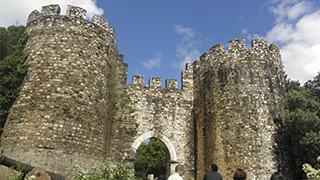Military Defense Line – Alentejo Central
In Central Alentejo, in Évora district, are the following towns and cities with significant assets to the defensive line:
Alandroal
The Juromenha region holds a strategic position near the River Guadiana, being a region quite popular since the beginning of human civilization. During the Roman period, in 44 BC, Julius Caesar sent strengthen the Roman defenses in the region. In the Muslim occupation that lasted nearly two centuries also defended well this region, but in 1167, D. Afonso Henriques took possession of the medieval castle, to be re-conquered by the Caliph Almanzor and in 1191 returned definitively to the Portuguese possession. In 1312, King Dinis granted a charter to Juromenha and strengthened its defense, from the castle to keep. During the War of Restoration, it was built a new fort that joined the previous ones. Due to the damage of battles and natural causes, Juromenha fortifications needed restoration work. Today, the defensive structure is classified as a Public Interest.
For Terena, this is a castle, whose date is indefinite, since there was already a settlement in previous Terena the reign of King Afonso III, who granted a charter in 1262. Only in the reign of Ferdinand, in 1380, it is emerging references of this fortification and only in the fifteenth century, during the reign of king John I, modernization works are performed, and even declared that the king had built this castle, handing the Order of Avis. During the reign of King Manuel in the sixteenth century, the donjon was remodeled and the palace of mayors was built. But in the earthquake of 1755, the fort was badly damaged and in the twentieth century was the object of intervention. It is currently classified as a National Monument. In 1980, the IPPAR took responsibility, intervening in its reconstruction, including the donjon. The Terena Castle is small and contains 4 towers of circular shape and the keep is divided into two floors.
Arraiolos
The village of Arraiolos goes back to the donation of Arraiolos farm, by D. Afonso II to D. Soeiro, bishop of Évora, which allowed its construction and the development of the settlement, there is a need to strengthen the town’s defenses, approving the contract between king Dinis, the Alcaide, the Courts and County of the village, which enabled the building of the castle in 1305. in 1306, the works took start with the authorship of John Simon, architect of this project. In the fourteenth century, the castle suffered a drop due to the surrounding conditions, but King Ferdinand, in 1371, took action and granted privileges to the inhabitants, a measure not relented useful. During the civil war, from 1383 to 1385, the village and the castle were donated to D. Nuno Alvares Pereira, who later left several military expeditions of Nuno Alvares Pereira against Castile. Over time, the castle found himself naked and in ruins until the time of the Restoration of Independence, under the reign of King John IV, the wall of the village and the castle had renovation works, however, the Donjon tower and the palace of mayors was still uninhabitable. With the 1755 earthquake, the damage increased. In the nineteenth century, the parade ground served as a cemetery for victims of cholera, which took account of the village. And only in the twentieth century, the fort was classified as a National Monument. Between 1959 and 1963, the General Directorate of National Buildings and Monuments gave the order for the restoration of the castle and its walls.
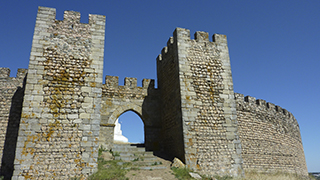
Borba
The Borba Castle is located in a great strategic value point for the defense of the Portuguese borders, especially along the twelfth century, after the conquest of Borba by King Alfonso II in 1217. However, the wall that is still visible today dates back to the reign of King Dinis, the impetus of its construction was given after the granting of the first charter in 1302. the existing fortifications suffered intervention and over time were built new buildings, as about urban, the keep, among others.
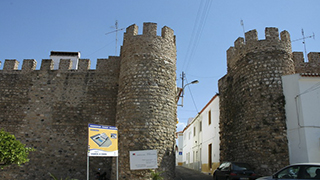
Estremoz
Estremoz Castle is on a hill north of the Ossa mountain range, and whose function was to defend the Alentejo streak. Estremoz has become one of the most important squares, strongboxes being related to several military episodes of the History of Portugal. This city was only incorporated into Portuguese rule in the thirteenth century, under the reign of King Sancho II, at the same time reconstruction of the castle. During his reign, King Afonso III was designed to increase the population and defense Estremoz, building the siege of the town and keep. The building of the walls were only completed in the reign of King Dinis, who also had built the royal palace, next to the castle. This building was buried the body of Queen Isabel, who later was moved to the Convent of Santa Clara-a-Velha of Coimbra. While alive, this queen will have avoided in Estremoz, a clash between his son D. Afonso IV and King Alfonso XI of Castile.
When the crisis of succession in 1580, the Castle of Estremoz and its Captain-General maintained their fidelity to Don Antonio, Prior of Crato. While the Castilian troops invaded Portugal, surrounding Estremoz, the only square Alentejo to resist. With the Restoration of Independence, Estremoz kept fighting for Portugal, and center point of the headquarters for the Portuguese troops. Something relented important victories in the battles of Elvas Lines in 1659, the Ameixial in 1663 and Montes Claros in 1665, ending the war.
After this critical moment, the defenses of Estremoz and its castle were modernized and new works were carried out, including four bastions, two half-bastions and ravelin, thus increasing the Estremoz defense lines.
In the eighteenth century, the fortification work continued, including the reconstruction of the royal palace and the chapel of Queen Santa Isabel. In the nineteenth century, Estremoz helped the Portuguese fleet that were in squares strong Elvas in the War of the Oranges in 1801, which was occupied by French troops, who in 1808 left the country during the Peninsular War. In the Liberal Wars, miguelistas forces killed 39 liberals who were imprisoned in the dungeons of Estremoz. Brought peace and in the early twentieth century, the fortified set – Castle Walls, of Breastplates Tower and Queen’s Chapel Santa – was classified as a National Monument since 1910 by the General Directorate of National Buildings and Monuments. It also authorized the restoration and upgrading of War Warehouses (former royal palace) and is currently the Pousada da Rainha Santa Isabel in tourist function, design gallery Estremoz Town Hall, the former Courtroom of King Dinis, as cultural function and religious function, the Chapel of Santa Isabel.
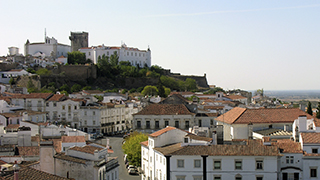
Évora
In 1518, King Manuel I ordered the construction of the New Castle, which would bring a revolution in the defensive structures of Évora, which was limited to the Middle Ages fortifications and contained in the Old Fence, a walled waist, already weakened. Done Castle, Evora became a military town was later reinforced by the bulwarks of Assa and chopper. In the realm Sebastian, part of the fortification has been changed but act as real deposit Common Barn. Already John V has allocated the building entirely military function, making it the Dragons Regiment of Évora, the command Soure Conde. With the evolution of needs in this regiment, it was necessary to carry out works, which were only completed after 1803 due to wars against Spain and financial difficulties, but the interior finishes ended in 1807. With the reform of the army, this regiment was extinguished and the Rules Cavalry 5 remained until 1940, moving to Estremoz. Until 1975, the New Castle housed the 16th Infantry Regiment.
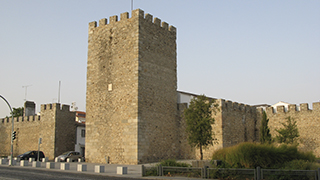
Montemor-o-Novo
The Montemor-o-Novo Castle is at the top of this area, originally the castle was home to his village, but with its development and expansion, left to stay in the castle.
During the reconquest of the Iberian peninsula, the village was conquered by Portuguese forces of King Sancho I command, who bet on their repopulation and development of the defensive line. It is believed that the castle was built at the time when D. Sancho gave the charter to Montemor-o-Novo. In the reign of King Dinis, the defenses of the region have changed, notably with the construction of the village fence, completed in 1365. During the fifteenth century, the castle had refurbishment in charge of precious stones Afonso Mendes de Oliveira master. Already in the fifteenth and sixteenth centuries, Montemor-o-Novo prospered both the regional trade but also by the presence of the Court, which remained long periods of time in Evora, this emblematic castle was both Manuel made the decision to proceed to the discovery of the way maritime India as Vasco da Gama has finalized its plans for this trip. Later, Sebastian awarded the title of Outstanding Vila in 1563, an old and a great village location. Over the centuries and wars, the fortified set consisting of the Montemor-o-Novo Castle, its walls and defensive properties, is considered as a National Monument in 1951. Over the years, they were carried out archaeological research.
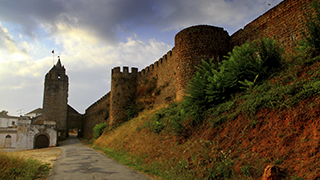
Mourão
The Mourao Castle was conquered from the Moors during the Reconquest of the Iberian Peninsula, and into the power of the Portuguese crown as a wedding dowry of Beatriz de Gusmão with D. Afonso III. His son, D. Dinis granted its charter in 1296 and two years later, promoted the improvement of the castle. Already in 1343, D. Afonso IV raised his keep. Over time, this fort was undergoing changes and reconstructions due to political and military needs, especially during the reign of King Manuel and the period of the Restoration of Independence. In order to protect not only the town and its farmland in the surrounding waist Mourao, but also to control the movement of enemy troops, it was erected a set watchmen of the highest points in the area. These sentinels also warned the forces who were in the stronghold. With evolution, the castle was losing its military purpose, since the wars and the time had new weapons, which the castle had no answer power. Currently, this is the picture of a time of conquests and re-conquests, offering the potential for an equity intervention, culture, urban and tourism, in order to increase its value and fight for its preservation.
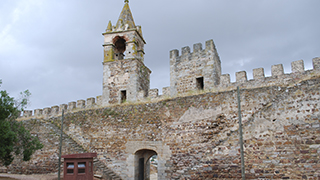
Portel
The Portel Castle comes after D. Afonso III granted permission for its construction in 1261 that in addition to its aim of defending Portel, was also home to John Peres Aboim and entailed its accession and social assertion of power. The castle has influences of medieval French military architecture. Along this fortification, a wall, called the Old Town was built. Depending on the development and evolution of Portel, new needs have arisen and with the passage of time, both the castle as this walled perimeter have been improved and re-qualified. Since the 30s of the twentieth century, the General Directorate of National Buildings and Monuments made several interventions in the castle, the last occurred in 2000 in its walls. Already in the 50s, this direction along with the house of Braganza, still owns the castle, carried out a campaign of archeology within the castle, being guided by the absence of scientific methodology, destroying archaeological evidence for the reconstruction of buildings. However, the castle continues to play an important role of tourist attraction to Portel and Vila Velha returned to their housing function.
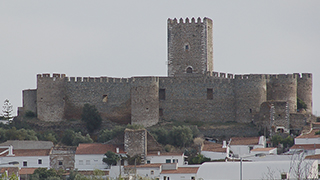
Redondo
Redondo Castle is a fortification classified as a National Monument since 1946 and as a Special Area of Protection in 1962. This rise was sent by D. Dinis, in the fourteenth century, but needs more historical data. From the 1990s, the image of entry was used on wine labels Port Ravessa, production of Adega Cooperativa de Redondo.
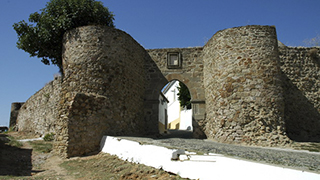
Viana do Alentejo
The Viana do Alentejo Castle is equidistant from the cities of Évora and Beja, with the southern foot of Mount Saint Vincent. This castle along with Alvito Castle are considered as one of the most remarkable architectural ensembles of the late Gothic period. King Dinis took over the region and granted him a charter to the town and donated one hundred pounds for the fortification works of the town, so start up the construction of the castle and around the village. Over the centuries, rehabilitation works and new constructions were carried out, but the castle landmarks, such as moats and bridges have become ruins and disappeared with time. Since 1910, the castle was classified as a National Monument and in 1940, the General Directorate of National Buildings and Monuments took charge of the works and worked restoration and consolidation in the walls and the battlements.
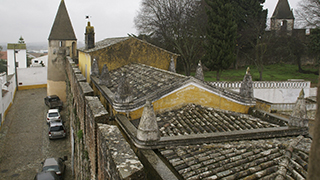
Vila Viçosa
Without a precise date of the first settlement, Viçosa village received its charter of D. Afonso III in 1270, which allowed the construction of the castle, to which the reign of King Dinis, the castle’s work ended. Over the centuries and reigns, this castle has undergone some improvements, however, when Ferdinand, Count of Arraiolos and 2nd Duke of Braganza received this village has added a palace to the castle, bringing the village Duchy headquarters of Braganza. His son, 3rd Duke of Braganza was considered a traitor by King John II, being murdered, it forced the family seeking exile in Castile. When they returned, his son Jaime de Bragança refused to live in his father’s palace and murdered his Spanish wife Leonor had built the current Ducal Palace. During her stay, they sent to expansion work, including bastions / turrets and was defensive.
In the War of Restoration, the Vila Viçosa Castle got a new ring of walls, between 1663 and 1664. Properly protected, the village survives the assault of Spanish troops in Claros Montes battle in 1665.
In 1910, this castle was classified as a National Monument. It is currently owned by the Foundation of the House of Braganza, who made several interventions of consolidation and restoration, throughout the twentieth century. In the castle is the Museum of Hunting with the collection of Manuel Lopo de Carvalho Caroça and the Archaeology Museum’s own foundation.
